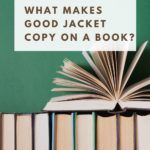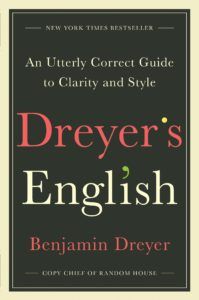The dust jacket is the first thing we interact with when picking up a new book. Obviously, there are exceptions, but in such cases as paperbacks, if the book doesn’t have a jacket, everything that might appear on the jacket will be printed on the cover, inseparable from the book itself. Though we don’t like to admit it due to an old saying, book covers, the art, and words are there for us to judge the book. They are meant to draw us in as perspective buyers whose eyes are scanning over stacks of other new books in the store. At their best, dust jackets let us taste a world the author has created in the text, making a case that your money and time is well spent on these specific words. Once you’ve picked up the book, the words you read in the next one to five minutes will largely inform your judgment when contemplating its purchase. Jacket copy, for many of us, informs potential readers what the book is about and, at least for me, if I’d be interested in reading the first few pages. So, what makes good jacket copy? What kinds of words actually push you to buy a book if all you know is what’s printed on the cover? I asked for several different people to share some thoughts about jacket copy. I spoke to people whose livelihood can very well be determined by the effectiveness of the book description on that first inside flap—editors, publicists, etc. Andrea Dunlop, a major publicist and the author of We Came Here to Forget and She Regrets Nothing, told me, “Book jacket copy is one of the most powerful marketing tools you have, and the essential parts of it can live on from the original query letter to the agent’s pitch to the eventual book jacket, press release, and online product description.” When considering what might live on from the query letter, I become tempted to now ask, who actually writes jacket copy? Is it the author? Every imprint handles this differently. Though in most cases it is not the author who writes those words, even if it is, they are never written in first-person. Benjamin Dreyer, the Copy Chief at the Random House imprint—whose New York Times Bestselling book Dreyer’s English is the most recent of the few truly engaging reads out there regarding editorial instruction and style—said, “The best jacket copy is, to be sure, attention-grabbing and inviting without being chockful of fulsome self-praise that potential readers have no reason to believe—or to put it another way, it shouldn’t sound as if the author, or the author’s mother, wrote it.” Objectivity and a flare of critical analysis seems to be the most reliable way to ensure you trust the words you’re reading when approaching a book you might want to buy. It’s not easy writing this kind of text. Another person who talked to me about the subject was Ethan Nosowsky, the Editorial Director of Graywolf Press. Concerning what it’s like to write jacket copy, he said the following: “It’s essentially advertising copy, and during my attempts early in my career I felt like I was learning a new language. There’s definitely an art to it: you want to, in some ways, channel the tone or mood or style of the book while doing some very concrete things very quickly to catch a potential reader’s interest. There are also shoals to avoid: empty adjectives and adverbs, dead words, words that only ever appear in the context of catalog or jacket copy, transparent hyperbole.” Ethan then shared with me Bring Me the Head of Quentin Tarantino, a recently published Graywolf book, as an example of jacket copy he finds enticing. You can find the jacket copy online, here. The jacket copy for Bring Me the Head of Quentin Tarantino is a great example of enticing copy, but the key factor in this kind of writing is reflecting the book. Jacket copy should approach a book on its own terms, and every book is different. Another fantastic example, one that deviates from what you typically see, is Yiyun Li’s Where Reasons End. Here, the jacket copy explains the author’s relationship to the book because the veil between narrator and author, in this case, is very thin, to say the least. You can check out the copy for Where Reasons End here. Old sayings often last due to some mote of truth tucked away or buried beneath all their connotations. “Don’t judge a book by its cover” is no exception. When we think about those decorative cloth bindings and covers that became popular in the 1800s, don’t judge a book by its cover makes a lot more sense, as the covers were often pretty to be pretty and resembled nothing that actually happens in the book. Today, though, there are thousands of people whose entire salaried careers revolve around making book covers that get you to judge the book accurately and in a positive light. Okay, now you’re thinking that there is still a drastic difference between the cover and what is inside, and there is. The book I mentioned above, Where Reasons End, has nothing more than text and abstract circles that don’t relate to the words inside. Though even then, it pushes you to read the words on the cover, and in this way, the jacket is highly effective. But you’re right, don’t assume too much—a bad book can have a fantastic jacket no doubt, but the people who write jacket copy and design dust jackets as part of their living put effort into what you see on the outside of a book, and you should consider the art and words printed. You don’t need to make a purchase based on the jacket, though many people do, but it should entice you to read the first page. Often if a cover can do that, it has done a good job and passes responsibility for the sale off to the author’s own words. From my personal experience, I once picked up a copy of Cynthia Ozick’s Trust because the art caught my attention, then the cover’s words seemed appealing enough to read the beginning, and I immediately bought the book after reading the first sentence: “After the exercise I stood in the muddy field (it had rained at dawn) and felt the dark wool of my gown lap up the heat and din of noon, and in that instant, while the graduates ran with cries toward asterisks of waiting parents and the sun hung like an animal’s tongue from a sickened blue maw, I heard the last stray call of a bugle—single, lost, unconnected—and in one moment I grew suddenly old.” Like Ethan Nosowsky said, “It’s essentially advertising copy,” like having a sample at Costco before buying their huge box of the product. Jacket copy is of little concern to us as readers besides those first few minutes when we pick up a book in the store. However, what you may not think about is that those first few minutes hold in their duration the life of an imprint and so many people’s careers. If books sell, people keep their jobs; if they don’t… “Powerful” is the adjective Andrea Dunlop chose to use when talking about jacket copy, and it is an incredibly accurate one, because many times your choice to buy a particular book affects many people who have poured so much time into that specific work, and they rely on the jacket to sway your interest in their favor. So, to conclude, speaking to the question this article is trying to answer—good jacket copy, put simply, makes you want to read.

















